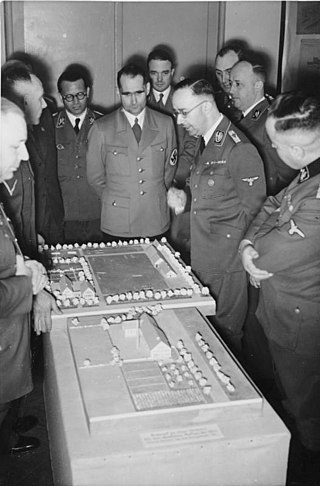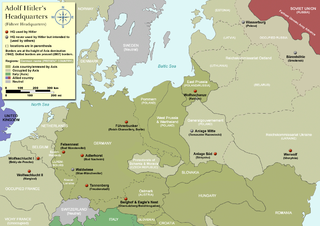
Heinrich Luitpold Himmler was a German politician who was the Reichsführer of the Schutzstaffel, a leading member of the Nazi Party of Germany, and one of the most powerful men in Nazi Germany, primarily known for being a main architect of the Holocaust.

The Generalplan Ost, abbreviated GPO, was Nazi Germany's blueprint for the genocide, extermination and large-scale ethnic cleansing of Slavs, Eastern European Jews and other indigenous peoples of Eastern Europe categorized as "Untermensch" in Nazi ideology. The campaign was a precursor to Nazi Germany's planned colonisation of Central and Eastern Europe by Germanic settlers, and it was carried out through systematic massacres, mass starvations, chattel labour, mass-rapes, child abductions and sexual slavery.

Operation Tannenberg was a codename for one of the anti-Polish extermination actions by Nazi Germany. The shootings were conducted with the use of a proscription list targeting Poland’s elite, compiled by the Gestapo in the two years before the invasion of Poland.

The Reichskommissariat Ostland was established by Nazi Germany in 1941 during World War II. It became the civilian occupation regime in Lithuania, Latvia, Estonia, and the western part of Byelorussian SSR. German planning documents initially referred to an equivalent Reichskommissariat Baltenland. The political organization for this territory – after an initial period of military administration before its establishment – involved a German civilian administration, nominally under the authority of the Reich Ministry for the Occupied Eastern Territories led by Nazi ideologist Alfred Rosenberg, but actually controlled by the Nazi official Hinrich Lohse, its appointed Reichskommissar.

Wilhelm Stuckart was a German Nazi Party lawyer, official, and a State Secretary in the Reich Interior Ministry during the Nazi era. He was a co-author of the notorious Nuremberg Laws and a participant in the January 1942 Wannsee Conference, at which the genocidal Final Solution to the Jewish Question was planned. He also served as Reichsminister of the Interior in the short-lived Flensburg government at the end of the Second World War.

Operation Tannenbaum, known earlier as Operation Grün ("Green"), was a planned but cancelled invasion of Switzerland and Liechtenstein by the Axis Powers during World War II.

Walter Christaller was a German geographer whose principal contribution to the discipline is central place theory, first published in 1933. This groundbreaking theory was the foundation of the study of cities as systems of cities, rather than simple hierarchies or single entities. He was primarily concerned with the urban space and worked on the role of towns as geographic-economic units, besides analyzing the relationships between towns of the same region.
Azerbaijani SS volunteer formations were recruited from prisoners of war, mainly from the Soviet Union and the countries annexed by it after 1939. Nazi Germany organised them to fight against the Soviet Union.

The Gaue were the main administrative divisions of Nazi Germany from 1934 to 1945.

The Military Administration in France was an interim occupation authority established by Nazi Germany during World War II to administer the occupied zone in areas of northern and western France. This so-called zone occupée was established in June 1940, and renamed zone nord in November 1942, when the previously unoccupied zone in the south known as zone libre was also occupied and renamed zone sud.

In Nazi Germany the Volksdeutsche Mittelstelle or VoMi was a Nazi Party agency founded to manage the interests of the Volksdeutsche - the population of ethnic Germans living outside the Third Reich. Ultimately coming under Allgemeine-SS administration, it became responsible for orchestrating the implementation of Nazi Lebensraum policies in Eastern Europe during World War II.

The Führer Headquarters, abbreviated FHQ, were a number of official headquarters used by the Nazi leader Adolf Hitler and various other German commanders and officials throughout Europe during World War II. The last one used, the Führerbunker in Berlin, where Hitler committed suicide on 30 April 1945, is the most widely known headquarter. Other notable headquarters are the Wolfsschanze in East Prussia, where Claus von Stauffenberg in league with other conspirators attempted to assassinate Hitler on 20 July 1944, and Hitler's private home, the Berghof, at Obersalzberg near Berchtesgaden, where he frequently met with prominent foreign and domestic officials.

The Greater Germanic Reich, fully styled the Greater Germanic Reich of the German Nation, was the official state name of the political entity that Nazi Germany tried to establish in Europe during World War II. The territorial claims for the Greater Germanic Reich fluctuated over time. As early as the autumn of 1933, Adolf Hitler envisioned annexing such territories as Bohemia, western Poland and Austria to Germany and the formation of satellite or puppet states without independent economies or policies of their own.

The zone interdite refers to two distinct territories established in German–occupied France during the Second World War after the signature of the Second Armistice at Compiègne, namely, a coastal military zone running along the entire Atlantic coast of France from Spain to Belgium, and the zone réservée in the northeast, intended for German settlement.

There were many areas annexed by Nazi Germany both immediately before and throughout the course of World War II. Territories that were part of Germany before the annexations were known as the "Altreich".

The Reich Commissioner for the Consolidation of German Nationhood was an office in Nazi Germany, which was held by Reichsführer-SS Heinrich Himmler.
Gerhart Hass was a German historian. His approach reflected the Marxist prism through which East Germany's historical establishment viewed their subject. He worked at the History Institute, part of the Berlin based (East) German Academy of Sciences and Humanities, where from 1974 he was a professor. His work concentrated on the History of Fascism in Europe and the Second World War.
The CI Army Corps, alternatively also referred to as Roman 101st Corps, was a corps-level unit of the German Wehrmacht during World War II. It existed only for a few months during the year 1945.
Giselher Wirsing was a right-wing German journalist, author, and foreign policy expert who was active during Nazi Germany and the Bonn republic. He was a member of the Nazi party and contributed heavily to the creation and propagation of Nazi propaganda outside Germany.
Kurt Weigelt was a German business manager of Lufthansa and Deutsche Bank, and a Nazi war criminal sentenced to two years in prison for being a supporting member of the SS.















